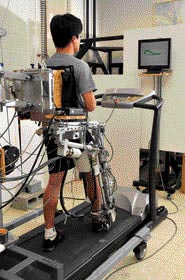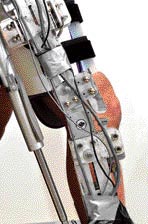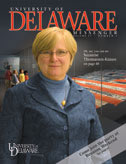A step forward for stroke patients

RESEARCH | A research team of engineers and physical therapists is hoping that technology—in the form of a robotic exoskeleton worn over the leg—may provide the key to helping stroke patients fully regain their ability to walk.
The team, from the departments of Mechanical Engineering in the College of Engineering and of Physical Therapy in the College of Health Sciences, has been awarded a five-year, $3 million grant from the Bioengineering Research Partnerships (BRP) program of the National Institutes of Health to continue a study on the treatment of movement disorders.
The project will focus on developing and testing novel rehabilitation solutions, including motorized and non-motorized exoskeletons for gait training of stroke survivors and other motor-impaired patients. Sunil Agrawal, professor of mechanical engineering and research team leader, notes that about 700,000 people suffer strokes each year in the U.S., and as many as 3 million survivors are living with the after-effects.
“It has a big impact on a person’s life,” John Scholz, professor of physical therapy, says. “Stroke not only affects many aspects of daily living but also can trigger further problems. For example, bad balance can lead to a fall and a broken hip. Improved emergency care has led to more stroke victims being saved, but many are severely impaired.”

The initial BRP grant, awarded in 2002 and led by Thomas Buchanan, professor of mechanical engineering, enabled the researchers to develop robotic prototypes and demonstrate the feasibility of the treatment approach through limited testing with human subjects. Significant progress also was made in the development of biomechanical models to predict muscle deficiencies during normal and abnormal gait.
“The competitively renewed grant will focus on new developments in robotic exoskeletons, embedded with a variety of position and force sensors to enable further testing,” Agrawal says. “It will also focus on modification of the two robotic exoskeletal devices developed during the initial research.”
The first of these is a simple non-motorized device, known as a gravity-balancing orthosis, which increases range of motion in impaired individuals by removing gravity from their joints.
The second is a device known as an Active Leg Exoskeleton, or ALEX, which fits over the leg and contains sensors as well as motors. While walking on a treadmill, ALEX users receive visual feedback from a video monitor on how well their gait matches a desired pattern. In addition, motors on the device help the users maintain their leg motion within a designated range by guiding the foot back when it moves outside that range.
ALEX not only improves motion but also maximizes learning, or retraining of the brain, Agrawal says, adding that research has found that survivors can benefit from using the device even years after their stroke.
Seok Hun Kim, a postdoctoral researcher in physical therapy working on the project, says that using an exoskeletal device can supplement traditional rehabilitation therapy, allowing a patient to make greater progress in walking.
“There is growing awareness that new technologies can make a major contribution to quality of life,” Scholz says. “Stroke centers are very interested in these devices and would provide an excellent setting for further testing on larger numbers of people.”
Article by Diane S. Kukich, AS ’73, ’84M





